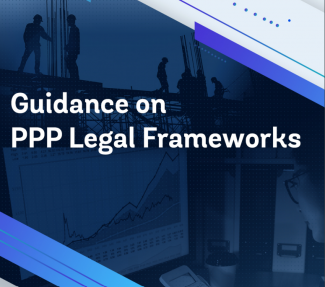PPP Legal and Regulatory Framework
Public-Private Partnership's (PPP) are compex long-term transactions affected by many areas of law, and a transparent and accountable legal and regulatory framework is necessary to build sustainable projects in line with public interest. This section offers comprehensive guidance on PPP projects, including resources on PPP contracts and practical advice on structuring and drafting key contractual clauses.
When planning and developing infrastructure projects, it is crucial to consider the existing legal, regulatory and social environment of the country:
-
Alignment with National Laws: A project agreement, no matter how well drafted, may be unenforceable and/ or irrelevant if it is inconsistent with the country's laws and regulations.
-
Legal and Regulatory Barriers: The existing laws/ regulations may prohibit or impede the proposed project and so the project may need to be adapted to fit within them.
-
Institutional Reforms: It may be appropriate to embark on more fundamental reforms of the institutions in the country such as reform of the judiciary/ establishment of a regulatory regime.
The PPP Legal and Regulatory Framework section provides resources, case studies, and other materials addressing key issues related to existing laws and the legal environment for PPP and sector reform projects. It includes due diligence checklists, examples of legislation, and various forms of regulation. For detailed guidance, visit the World Bank resource, PPP Legal Frameworks, on developing sustainable PPP legal frameworks.
Additionally, explore the ASLF Legal & Institutional Frameworks in Africa: A comparative analysis, which offers a comparative and comprehensive analysis of the existing African legal and institutional PPP frameworks.
PPI Database
The PPI Database, is a joint product of the World Bank Group and the Public-Private Infrastructure Advisory Facility, which seeks to identify and disseminate information on private participation in infrastructure projects in low- and middle-income countries. It highlights the contractual arrangements used to attract private investment, the sources and destination of investment flows, and information on the main investors. The data can be filtered by projects that include MDB support.
Case Studies
The World Bank’s Municipal Public-Private Framework Case Studies includes over 100 project summaries. These case studies can be browsed by Category, Country or Sector. A list of projects and project summaries which use "Leveraging Regulatory Changes" as innovative sources of funding are included.
The Disruption and PPPs Section, provides five case studies that help governments in emerging economies understand the increasing impact of disruptive technologies on PPP infrastructure projects. These case studies offer practical examples from various sectors and countries, both develop and developing, with guidance on how to manage existing and design future PPP contracts.
Resources
Explore the sections below or search our Library for resources on Infrastructure Finance and PPPs.











